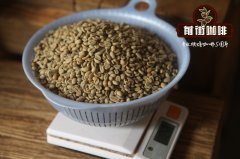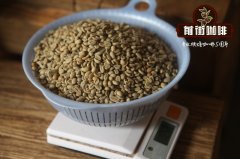What coffee producing areas are there in Cuba? What's the taste of Cuban Crystal Mountain coffee? How to cook Cuban coffee

Professional coffee knowledge exchange more coffee bean information please follow the coffee workshop (Wechat official account cafe_style)
What coffee producing areas are there in Cuba? What's the taste of Cuban Crystal Mountain coffee? How to make Cuban coffee to taste good?
Cuba, located in the Caribbean, is an island country under communist rule, and its capital is Havana. Cuba is famous not only for its snow-white beaches and cigar tobacco, but also for its excellent coffee. Cuba has a long history of growing coffee, and Jos é Antonio Gelabert introduced the first coffee factory to Cuba in 1748. In 1791, when slavery was abolished during the Haitian revolution, French colonists fled to Cuba, bringing better methods of coffee production to Cuba. Before the era of Castro, Cuba's coffee industry boomed, and coffee beans were once Cuba's number one export, with more "sugar" than life's necessities. In the mid-1950s, Cuba exported more than 20000 metric tons (22046 short tons) of coffee beans a year, all of which were sold at high prices, with most of the coffee exported to Europe, especially the Netherlands and Germany. In the late 19th century, the price of local coffee plummeted because of government policies and the chaos of the international political situation, so farmers turned to plant other crops.
Where is Crystal Mountain?
"Crystal Mountain" is not the name of Cuba's producing area. "Crystal Mountain" is the highest grade of coffee in the Cuban official coffee association classification system. The Cuban Coffee Association classifies coffee beans into nine grades according to particle size and flavor, with the highest being Crystal Mountain, Extra turquino, Turquino, Altura, Montana, Cumbre, Serrano superior, Serrano Corriente and Caracolillo.
At present, most coffee farms in Cuba are state-owned, but in 1990 the government released part of the land for coffee farmers to grow, but coffee production is still less than in previous years, Crystal Mountain production is very small, and coastal areas are hit by hurricanes from time to time, resulting in a shortage of supplies. Cuban coffee is mainly sold to Japan and France, while Japan almost monopolizes the highest quality Crystal Mountain Crystal Mountain, so it is rare to get high-quality Cuban coffee.
The planting area of Cuban coffee is divided into three parts, which are planted on the slopes and valleys above sea level from 1000 meters to 2000 meters above sea level, with the largest proportion of Santiago de Cuba and Granma in the east accounting for 70% of the country, followed by the central villa Clara and Sancti Spiritus accounting for 20%, and the western Pinar del Rio accounting for 10%. These areas provide a quite comfortable growing environment for coffee beans, with an average temperature of 21 degrees in winter and 25 degrees in summer. The rainfall is moderate, the humidity is evenly distributed all the year round, and the soil is deep and fertile. All planted Arabica (Arabica) varieties, to Tibica (Typica). In 2000, the United Nations Educational, Scientific and Cultural Organization (UNESCO) listed two coffee producing areas, Santiago and Guantanamo, as World Heritage sites.
Cuban Crystal Mountain Coffee is a typical island bean, taste clean, delicate, slightly sour but not exciting taste, with a special sweet flavor, very charming.
Cuba is familiar with and distant countries, familiar with the Cuban baseball team often win all levels of baseball world championships, far away is Cuba on the other side of the world in the beautiful Caribbean, coffee and other Cuban industries are state production and management, the best production of Cuban coffee for the Central Mountains region (Escambray), the Central Mountains area in addition to coffee there are quartz crystals and other precious minerals Therefore, the Central Mountains region (Escambray) is also known as Crystal Mountain. The production of Cuban Crystal Mountain coffee is rarely monopolized by Japan's Meiwa and France's Cafe Legal Coffee Company. Cuban Crystal Mountain coffee is a typical island bean with a clean and delicate taste, slightly sour but not strong but long-lasting, with sweet fruit aromas in the finish.
Cuban small crystal, the color of raw coffee beans is yellow, the beans are slightly smaller than those in the Caribbean, the natural washing method is adopted, and the coffee beans are dried by the sun in the latter section, the defective beans and empty shell beans are less, and the moisture content of coffee beans is high.
Shallow roasting City (fragrance): when injected with water, coffee powder and hot water produce a strong sweetness of honey, soft taste with a little peppermint refreshing, wheat aroma will not feel uncomfortable (Kaka), coffee aftertaste in the middle of the tongue like mint gum across the refreshing, this is a good sour coffee without killing breath.
Due to the slightly lower moisture content of coffee beans (between Brazilian beans and East African beans), the bean body is softer, and the taste of esterification into deeper baked milk is very smooth and soft.
Re-baking (general C): the pure sweetness of wheat, the sweet and sour taste of blueberry jam is discovered only slightly, or it may be masked because the aroma of brown sugar water is too strong. The aftertaste is a very long-lasting sweetness of melons and fruits in your mouth.
Qianjie recommended cooking methods: siphon, hand flushing
Degree of grinding: 4 (Japanese little Fuji R440)
V60 filter cup, 15g powder, water temperature 88-90 degrees, grinding 4, water powder ratio close to 1:14-15
Steaming in 30 grams of water for 30 seconds
Segment: water injection to 120ml cut off, slow water injection to 225ml
That is, 30-120-225g
Important Notice :
前街咖啡 FrontStreet Coffee has moved to new addredd:
FrontStreet Coffee Address: 315,Donghua East Road,GuangZhou
Tel:020 38364473
- Prev

Does Bolivian coffee taste good by hand? How do you cook it? Bolivian Coffee Hauvignon Manor Organic Water
Professional coffee knowledge exchange more coffee bean information please follow the coffee workshop (Wechat official account cafe_style) hand-made Bolivian coffee tastes good? How would you like it cooked? What is the flavor of organic washed beans in Bolivian Coffee Hauvignon Manor? Flavor: clean and balanced, soft, sweet, fine acidity, caramel, milk chocolate, figs and cantaloupe Bolivia
- Next

Is Cuban Crystal Mountain coffee expensive? The characteristics of Crystal Mountain Coffee beans? What will there be in cooking Crystal Mountain?
Professional coffee knowledge exchange more coffee bean information please pay attention to the coffee workshop (Wechat official account cafe_style) Cuban Crystal Mountain coffee is expensive? The characteristics of Crystal Mountain Coffee beans? What will be the flavor and taste of cooking crystal mountain? Crystal Mountain Coffee is famous for its unique taste and richness, thanks to Hemingway, the author of the Old Man and the Sea.
Related
- Detailed explanation of Jadeite planting Land in Panamanian Jadeite Manor introduction to the grading system of Jadeite competitive bidding, Red bid, Green bid and Rose Summer
- Story of Coffee planting in Brenka region of Costa Rica Stonehenge Manor anaerobic heavy honey treatment of flavor mouth
- What's on the barrel of Blue Mountain Coffee beans?
- Can American coffee also pull flowers? How to use hot American style to pull out a good-looking pattern?
- Can you make a cold extract with coffee beans? What is the right proportion for cold-extracted coffee formula?
- Indonesian PWN Gold Mandrine Coffee Origin Features Flavor How to Chong? Mandolin coffee is American.
- A brief introduction to the flavor characteristics of Brazilian yellow bourbon coffee beans
- What is the effect of different water quality on the flavor of cold-extracted coffee? What kind of water is best for brewing coffee?
- Why do you think of Rose Summer whenever you mention Panamanian coffee?
- Introduction to the characteristics of authentic blue mountain coffee bean producing areas? What is the CIB Coffee Authority in Jamaica?

